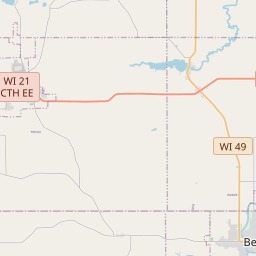Fargoville
Historical marker location:
29th Lane, Redgranite, Wisconsin
( Marker is on 29th Lane, 0.2 miles north of Cottonville Court, on the right when traveling north.)
Marker installed: 2020






© OpenStreetMap contributors
Loading...
Searching for other points of interest within 3 miles of this location.The state's capital, Madison, was named after James Madison, the fourth president of the United States.
About Waushara County
Waushara County Timeline
Waushara County, located in central Wisconsin, has a diverse and fascinating history. It was originally inhabited by Native American tribes, including the Menominee, Potawatomi, and Ho-Chunk people. European settlers began arriving in the early 1800s, primarily drawn to the area for its abundant natural resources such as timber, fertile land, and waterways.
The county was officially established on February 15, 1851, and named after a Potawatomi chief, Wau-shaw-rah. The logging industry played a significant role in the early development of Waushara County, with vast forests covering the region. Logging camps and sawmills were established, bringing economic opportunities and attracting more settlers to the area.
As the logging industry waned in the late 19th century, agriculture emerged as the dominant economic activity in Waushara County. Farmers planted crops like corn and wheat and raised livestock, while also taking advantage of the county's picturesque lakes and streams for fishing and recreation. Over time, the county saw the growth of small rural communities and the establishment of schools, churches, and businesses.
Today, Waushara County continues to be known for its natural beauty and recreational opportunities. With over 200 lakes, including the popular Big and Little Hills Lakes, it attracts visitors and residents alike who enjoy boating, fishing, and other outdoor activities. The county also boasts a thriving tourist industry, with resorts, campgrounds, and golf courses attracting visitors from nearby cities and beyond. Waushara County's rich history and scenic landscapes make it a unique and cherished part of central Wisconsin.
The county was officially established on February 15, 1851, and named after a Potawatomi chief, Wau-shaw-rah. The logging industry played a significant role in the early development of Waushara County, with vast forests covering the region. Logging camps and sawmills were established, bringing economic opportunities and attracting more settlers to the area.
As the logging industry waned in the late 19th century, agriculture emerged as the dominant economic activity in Waushara County. Farmers planted crops like corn and wheat and raised livestock, while also taking advantage of the county's picturesque lakes and streams for fishing and recreation. Over time, the county saw the growth of small rural communities and the establishment of schools, churches, and businesses.
Today, Waushara County continues to be known for its natural beauty and recreational opportunities. With over 200 lakes, including the popular Big and Little Hills Lakes, it attracts visitors and residents alike who enjoy boating, fishing, and other outdoor activities. The county also boasts a thriving tourist industry, with resorts, campgrounds, and golf courses attracting visitors from nearby cities and beyond. Waushara County's rich history and scenic landscapes make it a unique and cherished part of central Wisconsin.
Waushara County Timeline
This timeline provides a concise overview of the key events in the history of Waushara County, Wisconsin.
- 1848 - Waushara County is established and organized as a county in the state of Wisconsin.
- 1851 - The first permanent settlement is established in the county, located near the present-day City of Berlin.
- 1853 - The first townships are created in Waushara County.
- 1855 - The County seat is established in the City of Wautoma.
- 1861-1865 - Many residents of Waushara County serve in the Civil War.
- 1869 - The Wisconsin Central Railroad reaches the County, initiating a period of growth and development.
- 1891 - The State Tuberculosis Sanatorium is established in Waushara County, bringing economic growth to the area.
- 1930s - The Great Depression impacts many communities, including Waushara County.
- 1962 - The construction of the Big Roche-A-Cri Dam creates a recreational area in the county.
- 2005 - The Waushara County Courthouse undergoes major renovations.
- 2010 - The population of Waushara County reaches approximately 24,496 residents.